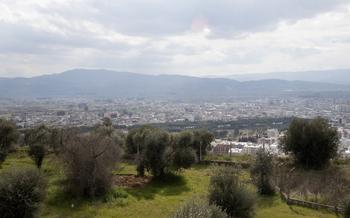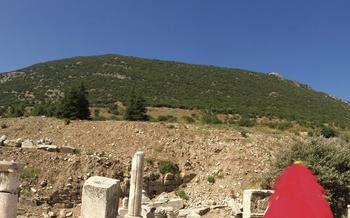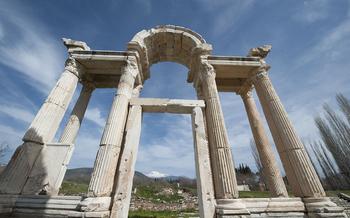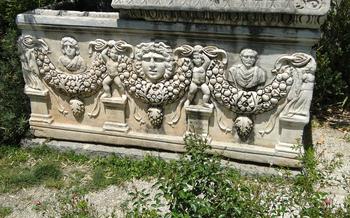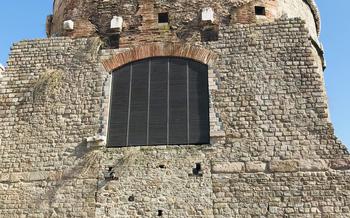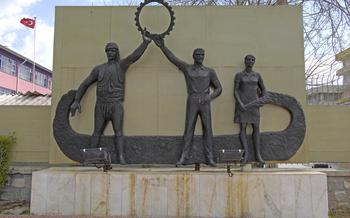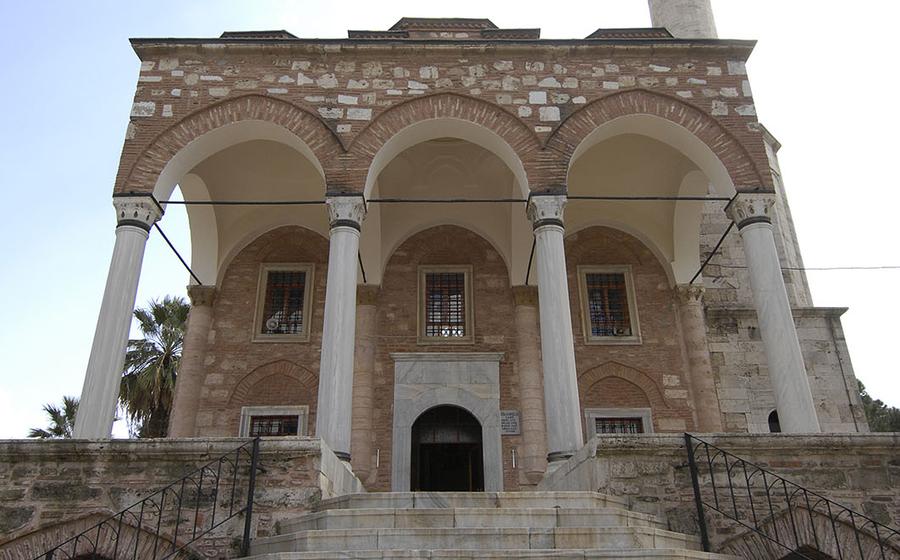
Ancient City of Ephesus
- Historical Significance
- Architectural Wonders
- Temple of Artemis
- Archaeological Museum
- Great Theatre
- Library of Celsus: A Symbol of Intellectual Endeavors
- Ancient Streets and Shops
- Agora: The Bustling Marketplace
- Cave of the Seven Sleepers
- House of the Virgin Mary
- Ephesus Archaeological Park: A Journey Through Time
- Ephesus Cats
- Best Time to Visit
- Travel Tips
- Insider Tip: Discover the Hidden Odeon
Historical Significance
Ephesus, an ancient city nestled in the heart of Aydın, Turkey, stands as a testament to the grandeur of the Roman Empire. Once a thriving metropolis and a prominent trade hub, Ephesus played a pivotal role in the ancient world. Its strategic location at the intersection of major trade routes made it a bustling center of commerce, attracting merchants, traders, and travelers from across the Mediterranean.
As a prominent city in the Roman province of Asia, Ephesus embraced the Roman culture and architecture, while retaining its own unique identity. The city's rich history is intertwined with the lives of significant historical figures, including the Virgin Mary and Saint John. According to Christian tradition, the Virgin Mary spent her final years in Ephesus, and Saint John is believed to have written the Book of Revelation while residing in the city.
Ephesus's contributions to early Christianity were immense. It was one of the seven churches of Asia mentioned in the Book of Revelation, and the city played a crucial role in the spread of Christianity throughout the Roman Empire. The city's significance as a Christian center is further evidenced by the numerous churches and religious monuments that were built within its walls.
Architectural Wonders
The ruins of Ephesus stand as a testament to the city's architectural prowess. The Library of Celsus, a magnificent structure that once housed over 12,000 scrolls, boasts an awe-inspiring facade adorned with intricate carvings and statues. The Temple of Artemis, one of the Seven Wonders of the Ancient World, was a colossal edifice dedicated to the Greek goddess Artemis, showcasing exceptional craftsmanship and elaborate design. The Great Theatre, capable of accommodating up to 25,000 spectators, is renowned for its remarkable acoustics and elaborate stage design, which made it a premier venue for performances and events.
These structures, remarkably well-preserved despite the passage of time, showcase the ingenuity and skill of ancient architects and builders. The use of marble and limestone, quarried from nearby mountains, contributed to the durability and grandeur of these edifices. The unique architectural styles, blending Greek and Roman influences, reflect the diverse cultural heritage of Ephesus. Exploring these architectural marvels offers a glimpse into the artistry and engineering achievements of the ancient world.
Temple of Artemis
The Temple of Artemis, one of the Seven Wonders of the Ancient World, stands as a testament to the grandeur and architectural prowess of Ephesus. Dedicated to the Greek goddess Artemis, this colossal temple was a marvel of engineering and artistry. Its construction, initiated in the 6th century BC, spanned several centuries, with each successive generation contributing to its magnificence.
The temple's grandeur was unparalleled, with its towering columns reaching towards the heavens and its intricate carvings adorning every surface. Its design reflected the fusion of Greek and Ionian architectural styles, creating a unique and awe-inspiring edifice. The temple's interior housed a colossal statue of Artemis, crafted from gold and ivory, further enhancing its splendor.
Despite its grandeur, the Temple of Artemis faced several challenges throughout history. It was destroyed by fire in the 4th century BC by Herostratus, a man seeking notoriety, and was subsequently rebuilt with even greater splendor. However, in the 1st century AD, the temple was again destroyed, this time by the Goths, and its ruins were left to decay.
Today, visitors can still marvel at the remnants of this once-magnificent temple. The scattered columns, intricate carvings, and the sheer scale of the ruins provide a glimpse into the grandeur of ancient Ephesus. The Temple of Artemis, though in ruins, remains a powerful symbol of the city's rich history and cultural heritage.
Archaeological Museum
The Ephesus Archaeological Museum is a must-visit for anyone interested in delving deeper into the rich history and culture of Ephesus. Established in 1964, the museum houses an extensive collection of artifacts excavated from the ancient city and its surroundings.
As you step inside, you'll be greeted by an impressive array of sculptures, pottery, and inscriptions that showcase the artistic and cultural achievements of the Ephesians. Among the highlights are stunning marble statues of gods and goddesses, intricate reliefs depicting scenes from mythology, and beautifully preserved mosaics that once adorned the floors of grand buildings.
The museum's collection also includes a wealth of everyday objects, providing a glimpse into the daily lives of the ancient Ephesians. You'll find cooking utensils, tools, jewelry, and even children's toys, all of which offer insights into the domestic and economic aspects of this once-thriving metropolis.
A visit to the Ephesus Archaeological Museum is an essential complement to exploring the ancient city itself. It allows you to gain a deeper understanding of the people who lived here, their beliefs, their art, and their way of life.
Great Theatre
The Great Theatre of Ephesus is an architectural marvel that has stood the test of time and continues to captivate visitors with its grandeur. Constructed in the 4th century BC, this colossal structure could accommodate up to 25,000 spectators, making it one of the largest theatres in the ancient world. Its impressive acoustics and elaborate stage design created an immersive experience for performances, from theatrical plays to gladiator battles.
Imagine yourself seated among the tiers of the theatre, surrounded by the buzz of anticipation as the actors take the stage. The acoustics are so remarkable that even a whisper from the stage can be heard clearly in the farthest rows. The intricate carvings and statues that adorn the facade and stage set the scene for a truly unforgettable performance.
While attending an event in the Great Theatre, you can't help but marvel at the ingenuity of the ancient architects and engineers. They cleverly incorporated natural elements into the design, using the surrounding hills as a backdrop for the stage. The theatre's orientation ensures optimal acoustics, allowing every spectator to fully immerse themselves in the performance.
Whether you're attending a modern-day concert or simply exploring the theatre's ruins, the Great Theatre of Ephesus offers a glimpse into the vibrant cultural and entertainment scene of the ancient world. Its timeless beauty and historical significance make it a must-visit for any traveler seeking to connect with the past.
Library of Celsus: A Symbol of Intellectual Endeavors
Amidst the ruins of Ephesus, the Library of Celsus stands as a testament to the city's intellectual and cultural achievements. Erected in the 2nd century AD by Julius Aquila in honor of his father, the Roman governor Tiberius Julius Celsus Polemaeanus, this magnificent edifice once served as a repository of knowledge and learning.
The library's awe-inspiring facade, adorned with intricately carved columns and statues, immediately captures the attention of visitors. The niches between the columns once housed statues of the Seven Sages of Greece, symbolizing the library's commitment to preserving and disseminating wisdom from around the world.
Inside, the library boasted an impressive collection of scrolls and manuscripts, covering a wide range of subjects, from philosophy and history to poetry and medicine. Scholars and students from across the Roman Empire flocked to Ephesus to access this treasure trove of knowledge, making the library a renowned center of learning in the ancient world.
The Library of Celsus is not merely an architectural marvel but also a poignant reminder of the enduring power of knowledge and the pursuit of intellectual enlightenment. As you stand before its imposing facade, let your imagination transport you back to a time when scholars and philosophers engaged in lively debates within these hallowed halls.
Ancient Streets and Shops
Strolling through the ancient streets of Ephesus is an awe-inspiring experience that transports you back in time. The well-preserved streets, lined with shops and houses, offer a palpable sense of the city's former glory. As you walk on the ancient cobblestones, imagine the bustling crowds, the merchants hawking their wares, and the daily life that unfolded in this vibrant metropolis.
The shops, with their stone counters and arched doorways, invite you to step inside and explore the goods that were once sold here. From pottery and jewelry to textiles and spices, the shops of Ephesus offered a diverse array of products to its inhabitants. You can almost hear the chatter of customers bargaining with shopkeepers, the clinking of coins, and the laughter of people going about their daily lives.
Pay attention to the details of the ancient architecture as you wander through the streets. Intricate carvings, decorative friezes, and colorful frescoes adorn the buildings, hinting at the artistic prowess of the Ephesians. Imagine the city in its heyday, when these streets were filled with color and life, and the sound of footsteps echoed through the narrow alleys.
Walking through the ancient streets of Ephesus is a journey through time, where you can connect with the past and feel the spirit of a once-great civilization. Let your imagination run wild as you explore these timeless remnants, and immerse yourself in the vibrant history of this extraordinary city.
Agora: The Bustling Marketplace
The Agora, the bustling marketplace and civic center of ancient Ephesus, was a vibrant hub of activity. Located at the heart of the city, the Agora was a vast open space surrounded by a colonnade of shops, temples, and government buildings.
In this bustling marketplace, merchants from far and wide displayed their wares, from exotic spices and textiles to locally produced pottery and jewelry. The air was filled with the sounds of haggling, the clinking of coins, and the laughter of shoppers.
The Agora was not just a place of commerce but also a center of civic life. Here, citizens gathered to discuss politics, exchange news, and participate in religious ceremonies. The Agora was also the site of important public events, such as festivals, elections, and trials.
Today, visitors to Ephesus can still see the remains of the Agora, including the foundations of shops and temples, and the impressive ruins of the bouleuterion, where the city council met. The Agora is a reminder of the vibrant and cosmopolitan nature of ancient Ephesus, a city that was once a major center of trade and culture in the ancient world.
Cave of the Seven Sleepers
Nestled amidst the tranquil hills surrounding Ephesus, discover the Cave of the Seven Sleepers, a site steeped in legend and religious significance. According to Christian tradition, this cave was the refuge of seven young men who sought shelter from persecution during the reign of Emperor Decius in the 3rd century AD. As the story goes, the seven youths fell into a deep slumber that lasted for centuries, only to awaken during the reign of Emperor Theodosius II in the 5th century AD. Their miraculous awakening symbolized the resurrection and the power of faith.
Venture into the cave's depths and immerse yourself in the mystical atmosphere that surrounds it. Explore the various chambers and alcoves, where the seven sleepers are said to have rested. Feel the weight of history as you touch the ancient walls and imagine the events that unfolded within these sacred chambers.
Beyond its religious significance, the Cave of the Seven Sleepers offers a unique glimpse into the region's rich cultural heritage. The cave's walls are adorned with inscriptions and carvings that provide clues about the lives of the early Christians who sought refuge here. Discover hidden symbols and motifs that erzählen the stories of faith, hope, and resilience.
As you leave the cave, reflect on the enduring legacy of the Seven Sleepers. Their story serves as a reminder of the power of faith and the enduring spirit of those who have come before us. Let their tale inspire you to embrace your own journey of self-discovery and spiritual growth.
House of the Virgin Mary
Nestled on the slopes of Mount Koressos, approximately 7 kilometers from Ephesus, lies the House of the Virgin Mary. This humble stone house holds immense religious significance for Christians, as it is believed to be the place where Mary, the mother of Jesus, spent her final years.
The site was discovered in the 19th century by a German nun named Anne Catherine Emmerich, who had visions of Mary's life. In her visions, Emmerich described a small house with a fireplace, a window, and an altar, which matched the structure that was eventually found.
The house is a simple, yet poignant reminder of Mary's life and her role in Christianity. Visitors can explore the small stone building, which consists of a single room with a fireplace and a niche where an altar once stood. The atmosphere is serene and contemplative, inviting visitors to reflect on Mary's life and her enduring legacy.
For many pilgrims, visiting the House of the Virgin Mary is a deeply spiritual experience. They come from all corners of the world to pay homage to Mary and to seek her blessings. The site is particularly significant for Catholics, who venerate Mary as the mother of Jesus and a model of faith and devotion.
Whether you are a religious pilgrim or simply a curious traveler, the House of the Virgin Mary is a place of peace and tranquility that offers a glimpse into the life of one of the most revered figures in Christianity.
Ephesus Archaeological Park: A Journey Through Time
The Ephesus Archaeological Park, a designated UNESCO World Heritage Site, encompasses the ancient city of Ephesus and its surrounding landscapes, inviting visitors to embark on a journey through time. This sprawling park encompasses meticulously preserved ruins, offering a glimpse into the grandeur and complexity of the ancient metropolis.
The park's dedication to safeguarding this historical treasure is evident in its ongoing efforts to conserve and maintain the site. Visitors can explore the ruins at their own pace or join guided tours led by knowledgeable experts who bring the city's history to life.
To enhance the visitor experience, the park provides a range of amenities and facilities. Informative signage and interactive exhibits offer insights into the significance of each structure, while designated paths ensure safe and accessible exploration. Visitor centers serve as hubs for information, offering maps, brochures, and assistance to ensure a seamless experience.
Whether wandering through the ancient streets, marveling at the architectural wonders, or simply soaking in the serene atmosphere, a visit to the Ephesus Archaeological Park is a journey that transports visitors back in time, allowing them to experience the majesty and legacy of this remarkable ancient city.
Ephesus Cats
As you wander through the ancient streets of Ephesus, you'll likely encounter a unique and charming sight—a colony of friendly felines known as the Ephesus cats. These cats have become an integral part of the city's allure, roaming freely among the ruins and welcoming visitors with their gentle purrs and curious glances.
Each cat has its own distinct personality and quirks, adding to the charm of the ancient city. Some cats are playful and love to interact with visitors, while others prefer to observe from a distance. Regardless of their personality, these cats are well-cared for and respected by the locals and visitors alike.
The Ephesus cats are not just mere animals; they are considered guardians of the ruins. They play a vital role in pest control, keeping the ancient city free from rodents and other pests that could damage the historical structures. Their presence adds a touch of life and warmth to the ancient stones, making the experience of exploring Ephesus even more enchanting.
As you explore the ancient city, be sure to interact responsibly with the Ephesus cats. Respect their space and well-being, and avoid disturbing them during their naps or mealtimes. Remember, these cats are an integral part of Ephesus's cultural heritage, and their presence enhances the overall experience of visiting this remarkable city.
Best Time to Visit
The timing of your visit to Ephesus is an important consideration to ensure a memorable experience. The best time to visit is generally considered to be during the shoulder seasons, spring (April-May) and autumn (September-October), when the weather is pleasant and the crowds are smaller. These seasons offer warm, sunny days ideal for exploring the outdoor ruins without the sweltering heat of summer. Additionally, the reduced crowds during these periods allow for a more intimate and immersive experience with the ancient city.
Visiting during the summer months (June-August) offers the advantage of longer daylight hours, but be prepared for hot and crowded conditions. Summer is the peak tourist season, so expect large crowds and potentially long lines at popular attractions. It's essential to stay hydrated, wear sunscreen, and start your explorations early in the morning or late in the afternoon to avoid the midday heat.
Winter (November-March) brings cooler temperatures and fewer crowds, making it a good option for those who prefer a more peaceful exploration. However, some facilities and attractions may have reduced hours or be closed during this time, so it's advisable to check beforehand.
To avoid the crowds altogether, consider visiting Ephesus on a weekday instead of a weekend. This strategy can significantly reduce the number of people you encounter, especially during the peak season.
No matter when you choose to visit, Ephesus offers a unique and awe-inspiring experience. With its rich history, architectural marvels, and captivating stories, this ancient city is a destination that will transport you back in time and leave you with unforgettable memories.
Travel Tips
- When visiting Ephesus, dress modestly and respectfully, as it is a religious and historical site.
- The site is best explored on foot, but you can also rent a bicycle or take a horse-drawn carriage tour.
- Local customs should be respected, such as avoiding loud noises and refraining from touching or climbing on the ruins.
- For accommodation, there are various options near the ancient city, from budget-friendly hotels to luxurious resorts.
- Dining options range from traditional Turkish cuisine to international fare, catering to different tastes and budgets.
- Before your trip, learn a few basic Turkish phrases to enhance your interactions with locals.
- Be prepared for crowds, especially during peak tourist season. Plan your visit accordingly or consider visiting during the shoulder seasons (spring and autumn) for a more tranquil experience.
Insider Tip: Discover the Hidden Odeon
Beyond the iconic ruins of Ephesus, there lies a hidden gem waiting to be discovered – the Odeon. This small but exquisite theater was once used for musical performances and poetry recitals. While less famous than the Great Theatre, the Odeon offers a more intimate and atmospheric experience.
Imagine stepping into this ancient auditorium, surrounded by well-preserved stone seats that have witnessed centuries of performances. Let the acoustics transport you back in time as you envision the melodies and voices that once filled this space.
The Odeon may be smaller in size, but its charm and historical significance are immeasurable. Seek it out during your visit to Ephesus and immerse yourself in the rich cultural heritage of this ancient city.
